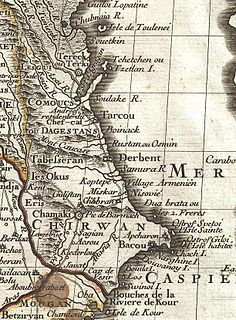Related Research Articles

Demetrius I, from the Bagrationi dynasty, was King of Georgia from 1125 to 1156. He is also known as a poet.
Khalilullah I (Halil) (1418–1465) was 34th ruler of Shirvan and son of Ibrahim I of Shirvan. He was succeeded by Shirvanshah Farrukh Yassar, his son.

Farrukh Yassar was the last independent Shirvanshah of Shirvan (1465–1500). In 1500, the first Safavid ruler, Ismail I, decisively defeated and killed Farrukh Yassar during his conquest of the area. Descendants of Farrukh Yassar continued to rule Shirvan under Safavid suzerainty, until 1538, when Ismail's son and successor Tahmasp I appointed its first Safavid governor, and made it a fully functioning Safavid province.

Shirvanshah, also spelled as Shīrwān Shāh or Sharwān Shāh, was the title of the rulers of Shirvan, located in modern Azerbaijan, from the mid-9th century to the early 16th century. The title remained in a single family, the Yazidids, an originally Arab but speedily Persianized dynasty, although the later Shirvanshahs are also known as the Kasranids or Kaqanids. The Shirvanshah established a native state in Shirvan.

The Shirvan province was a velayat (province) founded by the Safavid Empire on the territory of modern Azerbaijan and Russia (Dagestan) between 1501 and 1736 with its capital in the town of Shamakhi.
Shirvanshah Ali was fourth independent Shah of Shirvan, located in the modern day Azerbaijan Republic, after the death of his father Haytham II Shirvanshah. He fought along local feudals against Khazars around the Gates of Alexander. He also struggled against Rus' raids.

Muhammed II was fifth independent Shah of Shirvan and second Shah of Layzan whose father was first Layzanshah Yazid b. Khalid. He was nephew of first independent Shirvanshah Haytham b. Khalid. He attacked to Shirvanshah Ali, took him, his son Abbas and his grandson Abu Bakr as hostages. Abu Bakr escaped but others executed. Muhammed II Shirvanshah united crowns of Layzan and Shirvan and Yazidi branch of Shirvanshahs replaced Haythamid branch.
Ahmad of Shirvan was the eighth Shah of Shirvan and fourth Shah of Layzan. His throne was contested by his brother Tabarsaranshah Haytham ibn Muhammad, who later attacked Shirvan with the Sallarid ruler Ibrahim I in 968, in order to reaffirm Sallarid authority over Shirvan, forcing the Shirvanshah to pay him tribute, then he escaped to Darband and marched with local rulers to Shirvan but he eventually defeated by native people and retreated to Tabarsaran. Ahmad was succeeded by Muhammad.

Yazid ibn Ahmad or Yazid II was the tenth independent Shah of Shirvan.
Manuchehr I was the eleventh Shah of Shirvan. He is considered to be first fully Persianized ruler of the dynasty. Starting from his rule, the Shirvanshahs favoured names from the pre-Islamic Iranian past and claimed descent from characters such as the Sasanian monarch Bahram V Gur.
Ali II was twelfth Shah of Shirvan, ruling from 1034 to 1043.
Shirvanshah Manuchehr III The Great was the nineteenth independent Shah of Shirvan.
Abbas ibn Ali Mazyadid was heir to the throne of Shirvanshahs, the title of the Muslim rulers of Shirvan, located in the modern day Azerbaijan Republic. He was expected to become shah as "Abbas I" after his father Shirvanshah Ali's death. However, he was captured along with his son Abu Bakr and father in rebellion of his great uncle Muhammed III Shirvanshah and executed.
Khalilullah II was the 41st Shirvanshah, governing Shirvan under Safavid suzerainty between 1524—1535.
Burhan Ali was a self-declared Shah of Shirvan. He claimed to be son of Khalilullah II.
Gurban was the self-declared Shah of Shirvan after the downfall of Mehrab of Shirvan.
Gasim Mirza was the self-declared Shah of Shirvan after the death of Gurban Ali.
Kavus Mirza was the self-declared Shah of Shirvan in exile after the downfall of Gasim Mirza.
Abu Bakr Mirza was the final self-declared Shah of Shirvan after the downfall of Kavus Mirza.
Badr Shirvani was a Persian poet. He spent most of his career at the court of the Shirvanshahs, but received patronage from other rulers as well.
References
- ↑ Sara Ashurbayli. History of Shirvanshahs. p.247
Mehrab of Shirvan Born: ? Died: 1550 | ||
| Regnal titles | ||
|---|---|---|
| Preceded by Burhan Ali | Pretender to throne of Shirvanshahs 1550 | Succeeded by Gurban Ali |
| This biography of an Iranian ruler or member of a royal family is a stub. You can help Wikipedia by expanding it. |